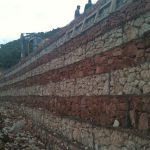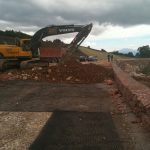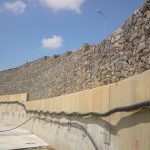Inspection of Gabion retaining walls reveals two main properties: these are flexibility and permeability of the gabion structure. Gabion retaining walls that can be designed in especially in landslide sites and weak soil passages are unrivaled compared to their alternatives. Flexible and permeable gabion retaining walls are ideal solutions in landslide sites. Furthermore, gabion retaining structures can be designed as rock retaining barrier walls. Gabion use is not limited to retaining walls and can also be used in river bed improvement. Especially in cases where the stones to be used in gabion are found on site, it provides unrivalled economy. Thanks to its 30% porous structure, retaining walls require no barbican and can conveniently discharge excess water pressure in the background. Furthermore, thanks to its flexible texture in weak soil passages, it adjusts with the ground subsidence enabling it to serve for long years. Gabion walls operate under two main principles in literature; weight structure and reinforces systems (as reinforced earth).
In gabion systems designed as weight structure, gabion wall designed as a pyramid structure and center of gravity of the current cross section is determined. Accordingly, forces that impact negatively on the stability of the gabion wall (earthquake, loads on the wall, background filling, etc.) are determined and compared to those impact positively (wall’s own weight, fillings to the front of the wall, etc) for completing sliding, topline, etc. inspections.
In reinforced gabion systems, the way gabion walls operate is different. In these systems, 1 or 0.5 m high box gabions are used on the front side and these are reinforced with geogrid, geotextile or steel rebar materials. Here, the stability of the system is obtained with the reinforcement material and after the sliding plane is determined, reinforcements are designed to bear shearing forces on the sliding plane. As in the previous systems, seismicity of the area where the wall will be built and the forces on the wall shall be considered beforehand.
In landslide sites, flexible and permeable gabion retaining wall is the ideal solution. Furthermore, gabion retaining wall structures can be designed as rock retaining barrier walls. Gabion use is not limited to retaining walls and can also be used in river bed improvement. Especially in cases where the stones to be used in gabion are found on site, it provides unrivalled economy. Gabions can be used for riverbed improvements in addition to retaining structures. Thanks to its 30% porous structure, retaining walls require no barbican and can conveniently discharge excess water pressure in the background. Furthermore, thanks to its flexible texture in weak soil passages, it adjusts with the ground subsidence enabling it to serve for long years. Gabion walls operate under two main principles in literature; weight structure and reinforces systems (as reinforced earth).
In gabion systems designed as weight structure, gabion wall designed as a pyramid structure and center of gravity of the current cross section is determined. Accordingly, forces that impact negatively on the stability of the gabion wall (earthquake, loads on the wall, background filling, etc.) are determined and compared to those impact positively (wall’s own weight, fillings to the front of the wall, etc) for completing sliding, topline, etc. inspections.
In reinforced gabion systems, the way gabion walls operate is different. In these systems, 1 or 0.5 m high box gabions are used on the front side and these are reinforced with geogrid, geotextile or steel rebar materials. Here, the stability of the system is obtained with the reinforcement material and after the sliding plane is determined, reinforcements are designed to bear shearing forces on the sliding plane. As in the previous systems, seismicity of the area where the wall will be built and the forces on the wall shall be considered beforehand.



